TUNI Virtual Desktop - Citrix
- Quick start guide
- Data storage and transfer
- Using Citrix with the application step by step
- Using Citrix in a browser step by step
- Frequently asked questions and common problems
Citrix Virtual Apps and Desktops (Citrix) is one of the virtualisation platforms / technologies used in TUNI Virtual Desktop. It is used to remotely access some special software, e.g. software requiring 3D acceleration. The virtual desktops and individual software published on the Citrix virtualization platform are intended for restricted user groups. For more information on using and accessing these restricted virtual desktops, staff can inquire at the IT Helpdesk. Student access to restricted desktops only through teaching or research staff. See list of software available in Citrix intended mainly for student use.
The Citrix virtualisation platform is a solution for virtualising Windows applications managed by the University and hosted on its own server capacity. Applications virtualised with Citrix can be run on all common terminal devices and operating systems. As the Citrix technical platform is part of the University’s internal network, the possibilities for deploying services limited to the internal network are greater than with cloud-based platforms. For the virtualisation of software requiring 3D acceleration, Citrix is often the most cost-effective option.
Quick start guide
Citrix can be accessed from both the application and the browser. Using the application is strongly recommended whenever possible. The application is free and has its own version for all the most common operating systems.

Using with the application
Download and install the appropriate version of the Citrix Workspace App / Receiver application in your device.
- TUNI Windows 10 PCs: you can find the application in the Software Center.
- Your own Windows device: you can find the application here https://www.citrix.fi/downloads/workspace-app/windows/workspace-app-for-windows-latest.html.
- TUNI MacOS device: you can find the application in the Managed Software Center.
- Own MacOS device: you can find the application here https://www.citrix.com/downloads/workspace-app/mac/workspace-app-for-mac-latest.html.
- TUNI and own Linux devices: you can find the application here https://www.citrix.com/downloads/workspace-app/linux/
- Chromebook, iOS and Android: you can find the application in the app store of your device (App Store or Google Play).
- Once the application is installed, sign in with your TUNI email address.
- You will see the apps and desktops available to your user account.
- Select the icon of the application/desktop you want.
Use with a browser
You need an up-to-date browser with HTML5 support. All major browsers such as MS Edge, Chrome, Firefox, Safari or Opera will work.
- Open your browser and go to https://virtual.tuni.fi.
- Sign in with your TUNI email address.
- You will see the apps and desktops available for your user account.
- Select the icon of the application / desktop you want.
Data storage and transfer
OneDrive for Business and P and S network drives are available on desktops for storing and transferring data & files. The use of OneDrive is recommended to ensure the best user experience, unless there are other obstacles to its use. The D: directory on the virtual desktop is only intended for temporary data storage, as the data stored there is regularly removed from the directory.
You can access OneDrive on the virtual desktop either by browsing through onedrive.live.com or by logging in to the OneDrive program pre-installed on the virtual desktop with your own TUNI ID by clicking on the icon at the bottom right of the virtual desktop. By signing in to OneDrive, you can view the contents of your cloud storage directly in the resource manager window on your virtual desktop.
More information on OneDrive for Business (TUNI) storage space.

Using Citrix with the application step by step
The guideline and screenshots were made on a Windows 10 workstation. Using the application in other operating systems may differ at some points from the text or images in this guide, but in general, the steps for using the application are the same as in this guide.
- Open Citrix Workspace.
- Sign in using your TUNI email address.
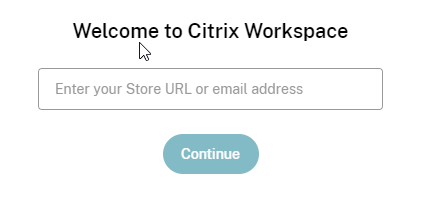
- Once you are signed in, you will see your shared Apps and Desktops in the Workspace window.
- Click on the app icon to connect to Workspace.
- The app will open, and the app window will appear like any other window on your Windows desktop and toolbar.
- When you are finished, log out via the Start menu of the virtual desktop using the Sign out option, in order to free the desktop for others to use.
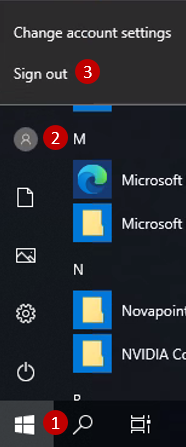
Using Citrix in a browser step by step
The text content and images of the steps in this guide were created on a Windows 10 computer using the Edge browser. The text or screenshots may differ slightly when used on other devices and browsers, but the main steps are the same in all.
- Open your browser and go to https://virtual.tuni.fi.
- Sign in with your TUNI email address and after logging in, go to the cogwheel icon to select Account Settings.
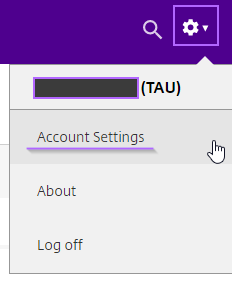
- Under Change Citrix Receiver choose whether to use the browser-based Light version or the application installed on your computer (assuming it is already installed). Current status shows you which one is used:
- Apps and desktops open in your browser = Light version
- Apps and desktops open in your local Citrix Receiver app = Application (Workspace App / Receiver / Viewer) depending on the operating system
- By clicking on Change Citrix Receiver you access a page where you can choose whether the application or the Light version is used. The Detect Receiver function tries to detect the version of the application installed on the terminal device if the application is already installed. It is not possible to install the application via this function.
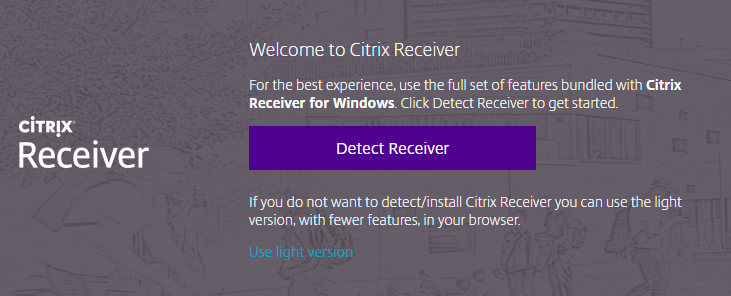
Workspace / Receiver
- When using Workspace to connect remotely, the application will open in a window like the one used for applications installed directly on the user’s device.
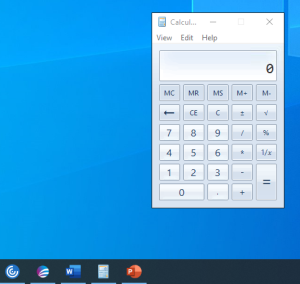
Light version
- When you use the Light version, applications open in a new tab in your browser. If you open more than one application, you can switch between them via the bottom bar.
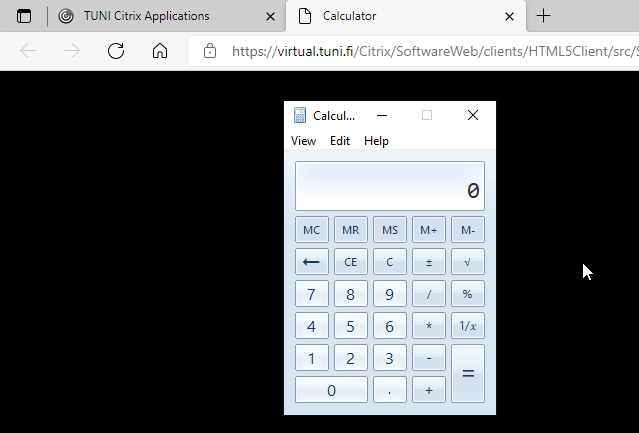
- The toolbar in the Light version allows you to upload files from the computer to the remote session and vice versa, and to manage the use of multiple screens.

Frequently asked questions and common problems
I can’t see anything in the service, or I can’t see a specific application or desktop.
The necessary resource is not connected to your account. Please contact the IT Helpdesk.
A virtualised application is running slowly.
- Avoid processing files with the application directly from the TUNI network disk because this will cause network congestion and result in the slower use of the application. Copy the files to be processed to the application server for use, e.g. in the Documents folder, and open them with the application from this location. At the end, remember to save the files back in your network drive / terminal device!
- The server may have several users simultaneously meaning that the platform may be temporarily so overloaded that the application slows down.
I cannot connect to the desktop or the application at all, or the connection is interrupted.
Please contact the IT Helpdesk and provide the following information as accurately as possible to speed up resolving the problem:
- When did you detect the problem (date and time)?
- Were you using an application or a browser?
- Which computer and operating system were you using?
- What type of network connection were you using (LAN, WLAN, mobile data)?
- Is your network connection working normally in other respects?
- Provide a screenshot of the error message or a description of its content as verbatim as possible.
IT Helpdesk
+358 294 520 500
it-helpdesk [at] tuni.fi (it-helpdesk[at]tuni[dot]fi)
helpdesk.tuni.fi